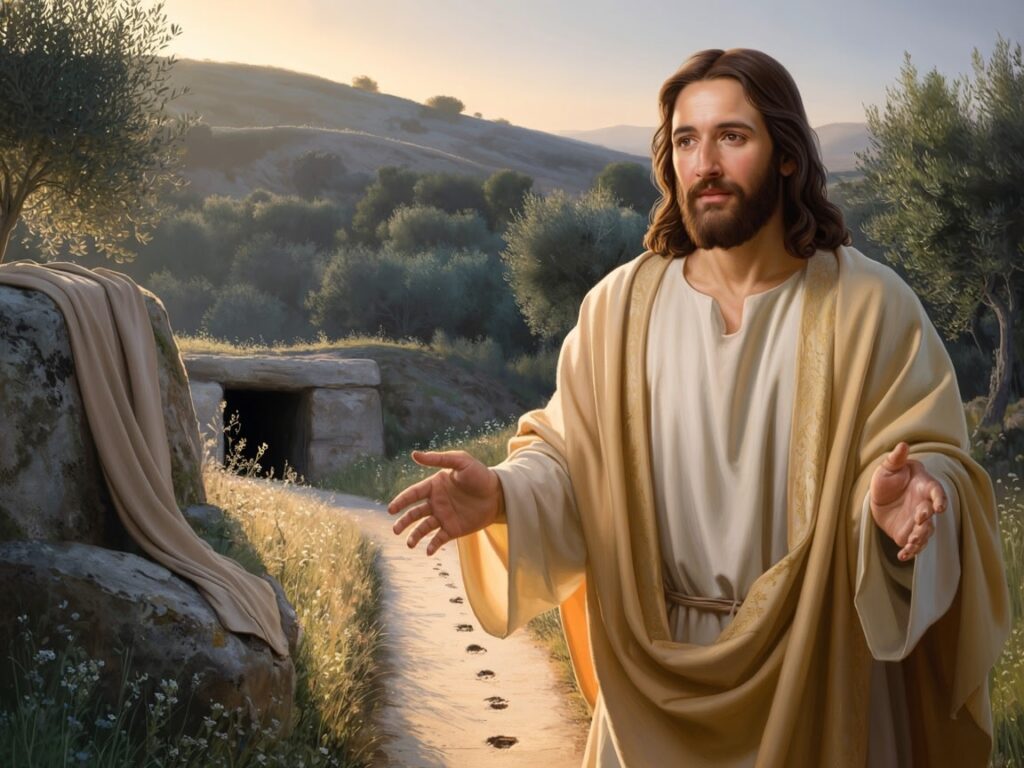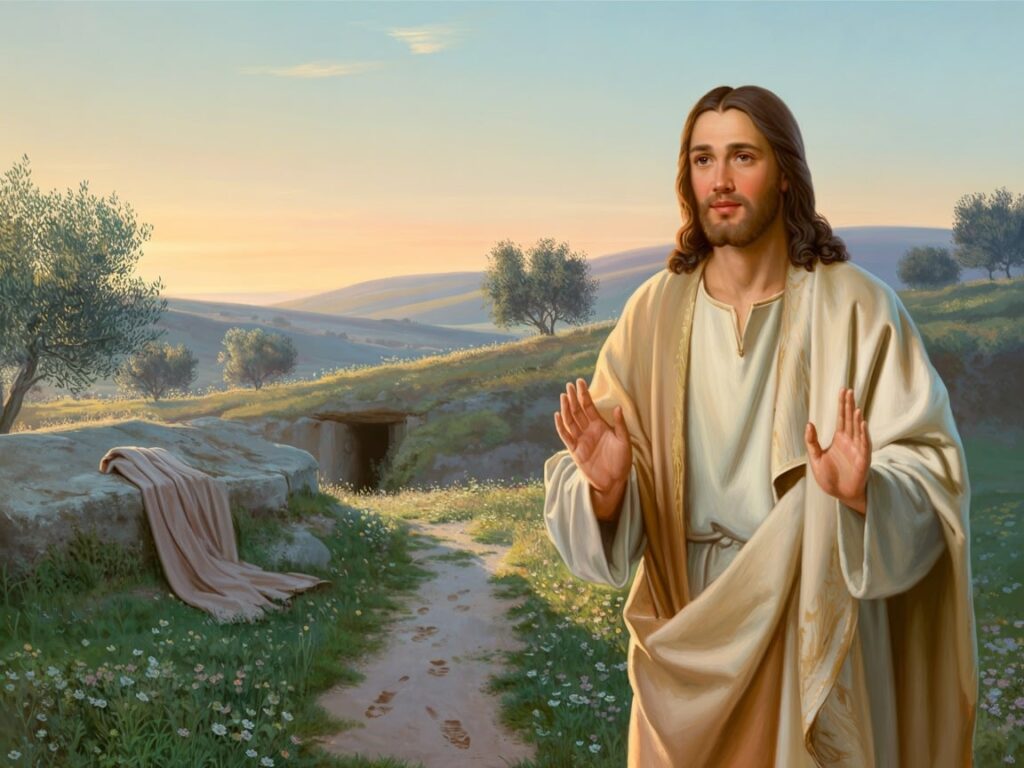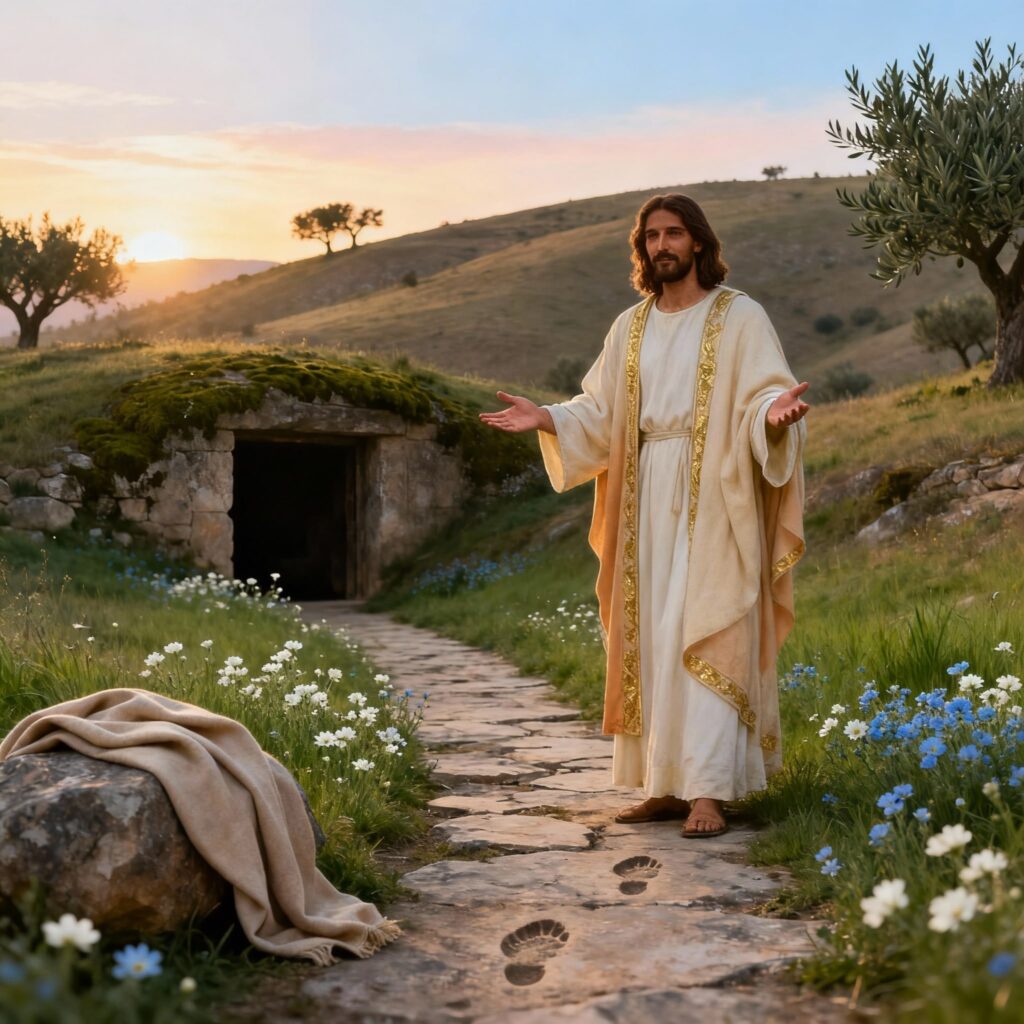Gospel of Jesus Christ according to Saint John
At that time,
Jesus said to the crowds:
«All those that the Father gives me
will come to me;
and he who comes to me,
I'm not going to throw him out.
For I have come down from heaven
to do not do my will,
but the will of the One who sent me.
But this is the will of the One who sent me:
that I may not lose any of those that he has given me,
but that I will resurrect them on the last day.
This is the will of my Father:
that whoever sees the Son and believes in him
have eternal life;
And I will raise him up on the last day.»
– Let us acclaim the Word of God.
To believe in order to enter into Life: to welcome the promise of the risen Christ
How faith in Jesus Christ transforms our relationship to death, trust, and the concrete hope of the Last Day.
In this passage from the Gospel of John (6:37-40), Jesus makes a promise that overturns all human logic: whoever believes in him will not be abandoned, but will be raised to eternal life. These words, which are also found in the Alleluia acclamation (John 11:25-26), speak to all generations troubled by mortality. This article is for those who seek to understand what it means, in the Christian faith, to be "raised on the last day" and how to live this eternal life that Christ proclaims, even here on earth.
- Gospel context: the revelation of a God who draws people to himself.
- Analysis of the passage: from the Father's will to the promised resurrection.
- Three thematic areas: trust, transformation, hope.
- Practical applications in spiritual and daily life.
- Echoes with Christian tradition and liturgy.
- Meditative practice and response to current challenges.
- Final prayer and spiritual roadmap.

Context
The Gospel of John, more focused on the revelation of Christ than on the narration of events, seeks to draw the reader into the mystery of the one it calls the Word made flesh. The passage under study is part of the discourse on the bread of life (John 6), delivered after the multiplication of the loaves. The crowds, fascinated but often confined to a material understanding of the miracle, hear Jesus speak of bread from heaven, a gift from the Father, food for eternal life.
It is in this climate of tension and misunderstanding that this word of authority and tenderness arises: all those whom the Father gives to the Son will come to him; and whoever comes, Jesus will not reject. This is therefore not a matter of selective sorting or spiritual privilege, but a revelation: eternal life flows from the intimate relationship between the Father, the Son, and each one of those who believe.
From a theological perspective, this text articulates three levels:
– the mission of the Son, which totally obeys the plan of the Father;
– divine faithfulness, which does not lose any of those it loves;
– and finally, the promise of resurrection, a sign that death does not have the last word.
The repetition of this promise in John 11, during the encounter with Martha and Mary at Lazarus's tomb, reinforces the coherence of the message: "I am the resurrection and the life." Thus, this passage is not a theory about the afterlife, but an invitation to transformation here and now. To believe in the Son is already to enter into the dynamic of the resurrection.
Analysis
The central idea of this passage rests on God's will for universal salvation: God wants no one to be lost. Christ, by agreeing to descend from heaven to fulfill the Father's will, demonstrates a twofold fidelity: to the mission he received and to the humanity entrusted to him. The expression "I will not cast him out" abolishes the fear of rejection, symbolizing God's welcoming heart.
On a spiritual level, the promise of resurrection is not an escape, but an assurance that everything entrusted to God remains in him. Jesus intimately links the act of faith and the experience of life: "whoever believes" is already living eternally, because faith brings the believer into the living communion of the Father and the Son.
This text also reveals a logic of joyful dependence: believing is not a solitary effort but a response to a call. The believer does not save himself by his own strength: he is carried along. The will of the Father and the faithfulness of the Son become the foundation of a trust that does not waver, even in the shadow of death.
The trust that opens the heart
The first movement of this text is one of trust. By declaring that he rejects no one, Jesus restores the bond broken by the original fear: the fear of being abandoned. The experience of faith thus becomes a learning of consent. To be given to the Son is to accept no longer controlling one's destiny but to be welcomed by a love stronger than death. This is why Christian faith is not an idea, but a trusting surrender.

The inner transformation
The promise «whoever believes has eternal life» invites us to understand that this life begins right now. The resurrection is not primarily a future event, but a process of inner transformation: a passage from anguish to joy, from solitude to communion. This transformation is expressed in participation in the Eucharist, where the believer receives the bread that came down from heaven. In each celebration, they hear the words: «Take and eat, this is my body.» It is there that the continuity between faith and eternal life is woven: the Word and the Bread become nourishment for the resurrected heart.
Hope that looks to the last day
Finally, the promise of the "last day" directs the believer's life toward an eschatological perspective. This last day is neither a threat nor an uncertain deadline: it is the fullness of the encounter. Christian hope does not consist in fleeing this world, but in perceiving in the visible the seed of the invisible. This is why the liturgy for the dead repeats these words: "And I will raise him from the dead." Every burial becomes a proclamation of trust. To believe in this promise is already to be resurrected in one's gaze.
Applications
In daily life: learning to receive life as a gift. Those who believe in Jesus learn to no longer define themselves by fear or success, but by relationship. In times of trial, this message liberates from despair: nothing, not even death, can separate us from the love of the Son.
Within the family sphere: this promise soothes grief and nurtures fidelity. It teaches us to speak of death without fear, passing on the Christian memory of hope.
In the life of the Church, it supports the mission of every community—to make known a God who rejects no one. Every baptism, every Eucharist is a proclamation of this faithfulness of the Father.
In society, it invites us to see broken human situations as a source of resurrection: exclusion, violence, loss. The gaze of the Son awakens eternal dignity in each person.

Traditional resonances
From the Church Fathers to the present day, this passage has nourished meditation on mercy and eternal life. Saint Irenaeus saw in the Father's will the plan to "recapitulate all things in Christ." Saint Augustine emphasized faith as an act of vision: "seeing the Son" is not a physical sight, but the opening of the heart to the presence of God.
The liturgy of All Saints and of the faithful departed takes this promise as its central theme. It roots Christian prayer in the conviction that every member of the Body of Christ shares in the victory over death. The Catechism of the Catholic Church (nos. 1002–1004) specifies that the resurrection begins with the life of grace: baptism already incorporates us into eternal life.
Finally, monastic tradition has often interpreted this saying as a call to inner vigilance. The monk lives each day "as if on the threshold of the resurrection," keeping his heart awake to the presence of the Son who draws him.
Meditation track
- Sit in silence, breathe slowly.
- Read the sentence slowly: "Whoever believes in the Son has eternal life.".
- To remember a situation where one felt rejected and to entrust it to Christ.
- Visualize the face of the Lord who welcomes without judging.
- Ask for the grace to believe that nothing is lost.
- End in silence, repeating: "And I will raise him up on the last day."«
This short, inner prayer, repeated regularly, becomes an anchor of confidence in moments of uncertainty. The resurrection then ceases to be merely a future prospect: it is a transformed present.
Current challenges
How can we speak of resurrection in a secularized world? The challenge is to make this promise audible without reducing it to a mere metaphor. The Christian faith does not deny the biological reality of death; it proclaims that a stronger relationship of love pervades it. Faced with suffering or collective tragedies, this conviction becomes an act of spiritual resistance.
Another challenge: understanding eternal life without setting it against earthly life. The believer is not a fugitive from the world but a witness to its transfiguration. The Christian mission consists of making every encounter a place of resurrection.
Faced with the temptation of contemporary despair, faith in the resurrection reminds us that all existence is called to beauty. This is what Pope Francis expresses: «Christian hope is boldness.» It does not deny the world’s wounds, but sows within them the promise of the last day.

Prayer
Lord Jesus,
You who descended from heaven to fulfill the Father's will,
Welcome those whom you call to eternal life.
We come to you in trust,
knowing that you don't reject anyone.
You are the Resurrection and the Life.
When our hearts doubt, remind us of your promise.
When fear imprisons us, free us through faith.
Grant your Church the grace to proclaim this mystery with joy,
and for each of us to live from now on in the light of the last day.
Remember those who have passed away.
May they rest in your peace,
and that one day we may be gathered together in your Kingdom.
Amen.

Conclusion
To believe in the Son is to enter today into the movement of the resurrection. This passage from the Gospel of John teaches us that God's faithfulness is more powerful than our fears. Eternal life is not tomorrow: it is already unfolding in the love received and given.
Every act of trust, every look of hope, every daily offering becomes a participation in the victory of Christ.
Embracing this promise transforms the way we live, we grieve, and love. May this word accompany us through days of light and night: the Son will raise us up on the last day.
Practical
- Read John 6:37-40 every morning for a week.
- Identify a place or relationship where you can build new trust.
- To connect each hardship experienced to the promise of the final day.
- To participate in a mass by offering an intention for the deceased.
- Meditating on the word "welcoming": what does it imply for me?
- Keep a hope journal to record the signs of life received.
- Conclude each prayer with "And I will raise him from the dead."«
References
- Gospel according to Saint John, chapters 6 and 11.
- Catechism of the Catholic Church, nos. 988-1019.
- Saint Augustine, Homilies on the Gospel of John.
- Irenaeus of Lyon, Against heresies, V, 36.
- Pope Francis, Christus Vivit, 2019.
- Liturgy of All Saints and Christian funerals.
- Benedict XVI, Spe Salvi, 2007.
- Saint Gregory of Nyssa, On the blessed life.



